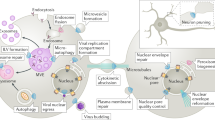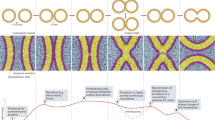Abstract
The endosomal sorting complex required for transport (ESCRT)-III proteins are known to assemble into filaments that mediate membrane remodeling and fission in various biological processes, including the formation of endosomal multivesicular bodies, viral budding, cytokinesis, plasma membrane repair, nuclear pore quality control, nuclear envelope reformation, and neuron pruning. The study of the regulation and function of ESCRT-III proteins is therefore crucial to understand these events and requires a combination of in vivo and in vitro experimental techniques. Here we describe two protocols for the purification of human and Drosophila ESCRT-III proteins from bacteria and their use in in vitro phosphorylation assays and atomic force microscopy experiments on membrane lipid bilayers. These protocols can also be applied for the purification of other proteins that are insoluble when expressed in bacteria.
Access this chapter
Tax calculation will be finalised at checkout
Purchases are for personal use only
Similar content being viewed by others
References
Guizetti J, Gerlich DW (2012) ESCRT-III polymers in membrane neck constriction. Trends Cell Biol 22:133–140
Lata S et al (2009) Structure and function of ESCRT-III. Biochem Soc Trans 37:156–160
Williams RL, Urbe S (2007) The emerging shape of the ESCRT machinery. Nat Rev Mol Cell Biol 8:355–368
Stoten CL, Carlton JG (2018) ESCRT-dependent control of membrane remodelling during cell division. Semin Cell Dev Biol 74:50–65
Christ L, Raiborg C, Wenzel EM, Campsteijn C, Stenmark H (2017) Cellular functions and molecular mechanisms of the ESCRT membrane-scission machinery. Trends Biochem Sci 42:42–56
Elia N, Sougrat R, Spurlin TA, Hurley JH, Lippincott-Schwartz J (2011) Dynamics of endosomal sorting complex required for transport (ESCRT) machinery during cytokinesis and its role in abscission. Proc Natl Acad Sci U S A 108:4846–4851
Wollert T, Wunder C, Lippincott-Schwartz J, Hurley JH (2009) Membrane scission by the ESCRT-III complex. Nature 458:172–177
Guizetti J et al (2011) Cortical constriction during abscission involves helices of ESCRT-III-dependent filaments. Science 331:1616–1620
Capalbo L et al (2016) Coordinated regulation of the ESCRT-III component CHMP4C by the chromosomal passenger complex and centralspindlin during cytokinesis. Open Biol 6:160248
Bhutta MS, McInerny CJ, Gould GW (2014) ESCRT function in cytokinesis: location, dynamics and regulation by mitotic kinases. Int J Mol Sci 15:21723–21739
Capalbo L et al (2012) The chromosomal passenger complex controls the function of endosomal sorting complex required for transport-III Snf7 proteins during cytokinesis. Open Biol 2:120070
Carlton JG, Caballe A, Agromayor M, Kloc M, Martin-Serrano J (2012) ESCRT-III governs the Aurora B-mediated abscission checkpoint through CHMP4C. Science 336:220–225
Acknowledgments
This work was supported by Cancer Research UK grant C12296/A12541 and Biotechnology and Biological Research Council grant BB/R001227/1 to PPD. IM and JME were supported by Biotechnology and Biological Research Council grant BB/J018236/1. AAJ is supported by a Well come Trust Senior Research Fellowship 202811.
Author information
Authors and Affiliations
Corresponding authors
Editor information
Editors and Affiliations
Rights and permissions
Copyright information
© 2019 Springer Science+Business Media, LLC, part of Springer Nature
About this protocol
Cite this protocol
Capalbo, L., Mela, I., Abad, M.A., Jeyaprakash, A.A., Edwardson, J.M., D’Avino, P.P. (2019). Purification of Recombinant ESCRT-III Proteins and Their Use in Atomic Force Microscopy and In Vitro Binding and Phosphorylation Assays. In: Culetto, E., Legouis, R. (eds) The ESCRT Complexes. Methods in Molecular Biology, vol 1998. Humana, New York, NY. https://doi.org/10.1007/978-1-4939-9492-2_15
Download citation
DOI: https://doi.org/10.1007/978-1-4939-9492-2_15
Published:
Publisher Name: Humana, New York, NY
Print ISBN: 978-1-4939-9491-5
Online ISBN: 978-1-4939-9492-2
eBook Packages: Springer Protocols




